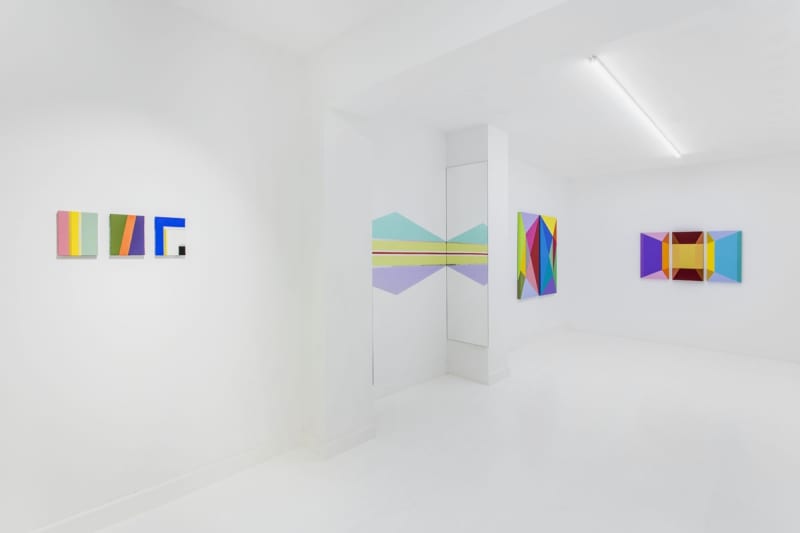The exhibition ‘Meaning’ starts right after opening the hidden door of Capsule Shanghai. A well-composed visiting route is introduced when passing a few barricades which function as a blockage with a ceremonial manner. The audience walks by a minimalistic and seemingly suspended sculpture in the garden. While entering the gallery space, Wang Zhiyi’s colorful practices since 2014 make their appearance. His geometric and colorful works complement perfectly the colored filters that he carefully pasted onto the windows. This delicate organization can be associated with the color patterns that Josef Albers (1888-1976) painted repetitively in his works. In fact, the artist was highly influenced by Albers’ color system and practice. Wang interpreted this concept by further developing it onto his practice: firstly, he divides the canvas into diagonal or symmetrical shapes. By adding another line or shape onto the canvas, the artist slowly structures the composition of the work. The skillful improvement of the artist can also be seen from the transition from the Gestalt (2014) series to the Critical (2017) series. The artist paints as if he is calculating a formula and presents it on the surface of the canvas. He cleverly uses the collision and contrast of different colors to tone down the tension in the composition of his work.
This motif envelops the exhibition; it seems like there is a rational act directing how the show is viewed. There is one good example to explain it, which is how the sizes of the doorways are reduced in the gallery space. This action restricts the capacity of people entering in the rooms but when the audience sees the show from a certain angle, the doors align. The works are well presented with the ingenious coordination of artificial and the natural sunlight in this white space. As sunlight splashes into the colored windows, the space is filled with a mystical feeling.
All of the elements above reclaim a cohesive order, experienced within the show, especially in the barricades. They are the most direct symbols conveying the idea of rationality that the exhibition is focused on. However, Wang’s ambitious concept appears in all the details of displaying the works and reorganizing of the space. The sharpen edges of the garden sculpture and the thin stand to hold the work can only be seen as the viewers are close enough to it. When lowering the view, one discovers a bush of pointing spikes (the artist calls them ‘metal grass’) cohabitant with growing weeds around it. The spikes are often associated with danger, which gives viewers a cold and uneasy feeling. This bush of metal grass brings a sense of hostility into the garden.
There is another work that breaks this harmony: The small purple room located at the end of the gallery, echoing the sound of wind and waves edited by Wang to represent the Elysium. By reading the text that Wang wrote for the work, the audience understands this work is referring to a mythological story. The romantic and poetic description guides the audience away from the highly restricted setting of the show. In the same room, there is a colored window piece from inside of the gallery. This is a preferable way of viewing the work for Wang, he wants the audience to see the world with different filters. The artist anticipates to be challenged by the viewers with different point of view than just follow his lead.



